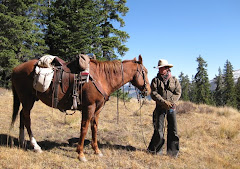
Part Two of Going Barefoot by Tom Muller
The horses’ hooves were trimmed regularly, usually every three to four weeks, depending on foot condition and growth. Tools in use were just a good knife, a rasp and an S-shaped finer rasp to contour the hooves edges. The wall was rasped down over the whole surface in a first step. As this was done quite often (not a lot of hoof material was lost from walking actually), it was not necessary to take off too much, just a few millimetres in most cases.
Then the sole was cut with a very sharp hoof knife. Here less was more as well. If you took off too much the foot became too sensitive and you could see small haemorrhages in the sole, which could easily bring your horse down for a couple of weeks. As a general rule you could say that we cut about two millimetres below the level of the hoof wall, cutting deeper towards the frog. The frog itself was never cut, unless some parts were hanging loose.
As a last step the wall was slightly rounded with the S-shaped rasp, then the hooves were oiled. Oiling was imperative, especially during the dry season. Hooves would become very brittle and small parts of the wall could break out/off, in which case this part was rounded with a knife immediately. I had to trim a few horses’ feet that were so hard I had to put them overnight in an improvised water basin. I could not get any horn off the sole with my knife. During the rainy season all this changed to the opposite, when the horses were sloshing through water all the time.
Now I am no farrier, nor a hoof specialist, I was just an old fashioned horse trooper who had to keep his mount in perfect condition for service. When I had been promoted to officer there were a few things that I would check all the time on inspections and during operations. Weapons you never had a problem with, because they were the life insurance of each trooper, but so was his mount. Especially troopers who passed selection and joined the unit because of the reputation but not because of the love for horses, had to be looked after. Points that needed regular controlling were the horse’s feet and the back (including the saddle, blankets or pads and the girth/cincha).
I can only put down my experiences over the years and how we kept our mounts operational. A few points should be mentioned because to me, they seem very important. The type of horse used for this kind of barefoot “work” is imperative. You need a good working type horse, not too big with a naturally good hoof. The material in the horses paddock should consist of the same material it walks regularly. Now this might be difficult, but what I mean is the following: we operated on sand, so half the paddock was filled with sand; we operated on rocky ground, so we used these rocks to fill the other half of the paddock with this material. It was funny how some horsey and very knowledgeable people from all over the world would be surprised to see our horses rest in the rocky part, three legging it under one of the big Acacia trees.
Regular light trimming, rather than doing things the hard way every eight weeks was the key to success, at least in our case.
There are so many things I could still talk about, not just going barefoot, maybe if you people are interested, I’ll write some more about my horse experiences.
Tom, thank you for sharing. This is great. Informative, interesting, and inspiring. I for one would like to hear more. Friends and readers, please write me at LostTrailRanch@gmail.com if you’d like to send a comment to Tom, or if you too would like to read more.
Thanks again,
Gin






